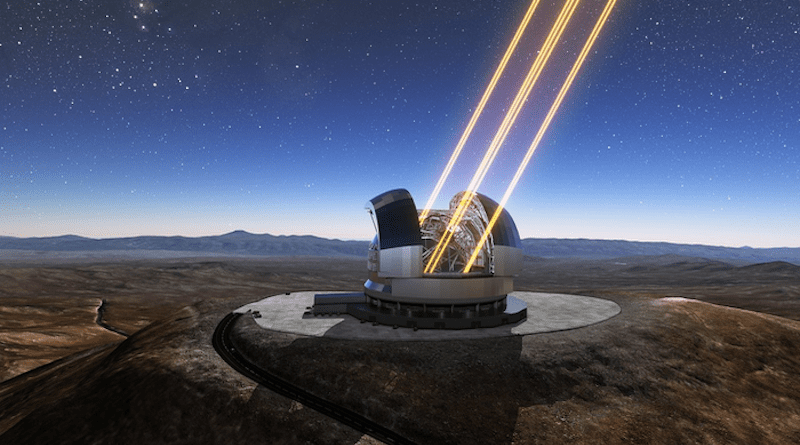Portugal Participates In Development Of A First-Class Instrument For Largest Telescope In World
A research team from the University of Lisbon and University of Oporto (Portugal) participate in the development of METIS (Mid-infrared ELT Imager and Spectrograph). This powerful instrument will equip the largest telescope in the world – the Extremely Large Telescope (ELT) – under construction by the European Southern Observatory (ESO) in Armazones, Chile.
At this critical acceptance stage of the complete and final METIS design, ESO is presenting an illustrative film demonstrating the exceptional capabilities of the instrument.
METIS will detect radiation that is invisible to the human eye, that is, radiation that is “felt” in the form of “heat”. The instrument will take advantage of the ELT’s giant primary mirror, measuring around 39 meters, to study a myriad of scientific topics, from objects in our solar system to distant active galaxies with revolutionary precision.
“This is one of the ELT’s most complex instruments and the participation of the Portuguese team is proof of national capabilities in the development of large international projects. Involvement in this project not only allows them to apply their experience, but also to increase it, given the inherent challenges. It also allows Portugal to be at the forefront at the time of observations, and, in addition, promotes the participation of industry, involving the ecosystem as a whole”, says Marta Gonçalves, manager of Science and Education projects at the Portuguese Space Agency.
“Participating in the development of METIS has been a huge challenge, which has put our capacities for innovation, simulation, and construction of instruments for Astrophysics to the test. Projects like this also help to develop and promote the participation of Portuguese industry in major international projects. They strategically position us at the forefront as teachers, researchers, engineers and students”, says António Amorim, responsible for the Portuguese participation in METIS, Professor in the Physics Department of the Faculty of Sciences of the University of Lisbon (Ciências ULisboa) and member of CENTRA – Center for Astrophysics and Gravitation.
The Portuguese participation in the development of METIS has several fronts. The main contribution is the construction of the mechanical support structure, alignment and access to the instrument called Warm Support Structure (WSS). Portugal also contributes to the METIS operations team and also to the scientific team.
The total cost of the METIS instrument is around €95 million, and its mass is around 12 tons (equivalent to a double-decker bus). For Mercedes Filho, manager of METIS project in Portugal and researcher at the Physical Engineering Department at the Faculty of Engineering of University of Oporto (FEUP), “the WSS has extreme requirements. On the one hand, the WSS must position the instrument with an accuracy of 10 millionths of a rotation and 100 millionths of a meter. On the other hand, the WSS must withstand a major earthquake in complete safety, being able to support an equivalent mass of 40 tons!”.
The METIS project also involved the participation of PhD and Master’s students, namely André Bone and Ricardo Costa, the former a PhD student in Physical Engineering at Ciências ULisboa and the latter a Master’s student in Mechanical Engineering at FEUP.
As for Astrophysics, many scientific discoveries are being prepared in detail given the extremely high cost and competition for infrastructure, as explained by Paulo Garcia, co-responsible for the Portuguese participation in METIS, researcher at CENTRA, and professor at the Department of Physical Engineering (DEF) at FEUP: “Portugal will have privileged access to METIS, to carry out observations of celestial phenomena with a top scientific instrument that transports us to the future of astrophysics. METIS will allow an unprecedented study of several astrophysical topics, and our priority at CENTRA is to study gravity in the vicinity of the supermassive black hole at the center of our galaxy. In particular, we intend to detect new stars in orbits closer to the black hole than currently known and study their motion.”
Other Portuguese researchers involved in the scientific preparation of this initiative are André Moitinho, Professor at Ciências Ulisboa, Koraljka Muzic, researcher at FEUP, and Alexandre Correia, professor at the Physics Department at the University of Coimbra.
The ELT is under construction in Armazones, Chile by ESO. The ELT will be the largest terrestrial optical and infrared telescope when it begins operations, scheduled for the middle of this decade. With its 39-meter diameter primary mirror and advanced adaptive optics systems, the telescope will be able to see details six times finer than the James Webb Space Telescope and 20 times finer than the Hubble Telescope.

